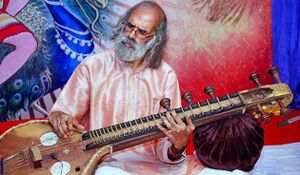A. Ananthapadmanabhan
A. Ananthapadmanabhan | |
|---|---|
 | |
| Born | July 29, 1951 Trivandrum, Kerala |
| Nationality | Indian |
| Citizenship | India |
| Occupation |
|
| Organization | All India Radio Thrissur |
A. Ananthapadmanabhan (born 29 July 1951) is a classical musician and veena maestro from India, in the Classical Indian Music genre specializing in Carnatic Music.[1]
Ananthapadmanabhan hails from a family of accomplished musicians that include Shri T.S. Ananthakrishna Iyer his father, Mrs. Gomathy Chidambaram, his cousin and many others. He is regarded as one of the greatest Veena artists, known for his own unique "gayaki" style. He is the recipient of a national award for the musical feature Sayoojyam and has also contributed to a number of award-winning films - Aswatthama, Veenapoovu, and Aparna. A. Ananthapadmanabhan has composed many songs in Carnatic music. He had been performing since the 1970s across Nationally and Internationally. Notable performance Internationally was for the Golden Jubilee of UNESCO in Paris and at prestigious Navarathri Music Festival, a nine-day music fiesta at Thiruvananthapuram Navarathri Mandapam.[2]
Ananthapadmanabhan has developed his own fingering style, making gamakas by pulling strings rather than gliding, which necessitates a deep understanding of note position because swarasancharas (music) is made by varying string tension. His ability to play the Sitar aided him in acquiring speed and learning how to pluck the strings on the veena in a unique way.[3]
Early life and education
Ananthapadmanabhan was born on 29 July 1951 in Trivandrum. His father T.S. Ananthakrishna Iyer, was a Vanika and disciple of Karamana Parameswara Bhagavathar of Manjapra school and also a Professor in Engineering at College of Engineering, Thiruvananthapuram. Ambience at home was musical. He learnt the basics of playing veena from his father. He trained himself by listening to his Father playing and also by practicing for many hours a day just one raga until he explored the special features of the raga and how best can it be played
During his college days while pursuing a Degree in Science specializing in Mathematics he would spend all his evenings and free time either practising or listening to concerts. During those times he had an opportunity to enjoy concerts of Veena S. Balachander, K.S. Narayanaswamy, Mysore Doraiswamy Iyengar, M. D. Ramanathan, Semmangudi, Bade ghulam Ali Khan, Pandit Ravi Shankar and many other Stalwarts.These experiences combined with his expertise in playing Sitar, a music instrument used in Hindustani Music made him appreciate and experiment with Fusion music. He has acquired an unique and Innovative skill of playing both Hindustani and Carnatic Music in Veena though Veena is more identified as an instrument of Carnatic Music.
Magical mellifluousness on the Veena by the great Maestro Veena S. Balachander made an impact on Ananthapadmanabhan when he attended a concert by the great Maestro and listened to his concerts, which influenced his decision to choose Veena and taking a break from Sitar.
After graduating his Passion for Music was more than Maths he aspired to be a musician.
Ananthapadmanabhan also worked on musical experiments in composing Fusion music. In 1970 he was one of the pioneer and innovative Fusion music to combine Western, Hindustani and Carnatic music eventually gaining recognition in the city in the genre of Fusion Music which was very new and Innovative for 1970’s
Career
Ananthapadmanabhan began performing at local events and concerts while he was still in college. After graduating he played the veena and the sitar for Thunder Birds Orchestra and also performed alongside top playback singers in Malayalam movies. In 1975, he was appointed as a veena staff artiste in All India Radio, Thrissur, and became a full-time musician.[4]
In 1976, Ananthapadmanabhan composed and directed Triveni Sangaman’, it was a confluence of Carnatic, Hindustani and Western music. This composition gained mass popularity across Kerala, which resulted in spearheading Ananthapadmanabhan's career.
Ananthapadmanabhan's album Stress Relief in Raga Bowli, based on the Bhagavad Gita and released as part of Music Therapy Treatment for Sanjeevanam Ayurveda, has also earned widespread recognition. He is currently working on a project that will include Carnatic Music as a subject in schools alongside other courses.
Awards
- 1996: Sangeeta Nataka Akademi Award, national award for the musical feature Sayoojyam
- 1996: Ganakalathilaka from Goa Carnatic Music Society, national award for the musical feature Sayoojyam
- 2011: Chembai Award
Personal life
Ananthapadmanabhan is married to Usha Usha, who is also a renowned Veena player and teacher. She is a graduate of the Swathi Thirunal College of Music. The couple had a son named Anand Kaushik, a child prodigy in music, a veena maestro, playback singer and engineer by profession. who passed away at the age of 36.[5]
Ananthapadmanabhan is fluent in Malayalam, Tamil, and Hindi.
References
- ↑ "A.Ananthapadmanabhan". ANURADHA MAHESH. Retrieved 18 February 2022.
- ↑ "Navarathri Mandapam - the performance hall of Padmanabhapuram Palace". www.padmanabhapurampalace.org. Retrieved 18 February 2022.
- ↑ Sangameswaran, A. (29 June 2017). "A melodious confluence". The Hindu. Retrieved 18 February 2022.
- ↑ "A musical concert by Veena Vidwan A Ananthapadmanabhan - Times of India". The Times of India. Retrieved 18 February 2022.
- ↑ Daily, Keralakaumudi. "Veena artiste Anand Kaushik passes away". Keralakaumudi Daily. Retrieved 18 February 2022.